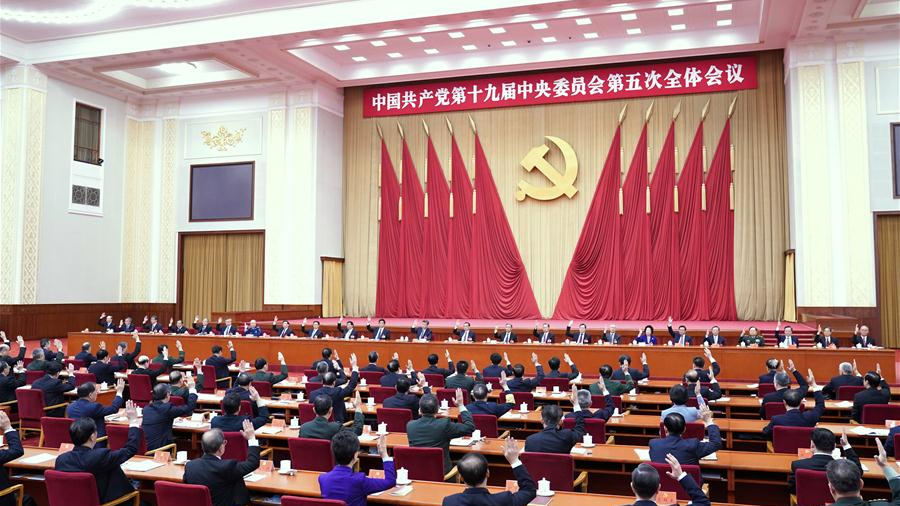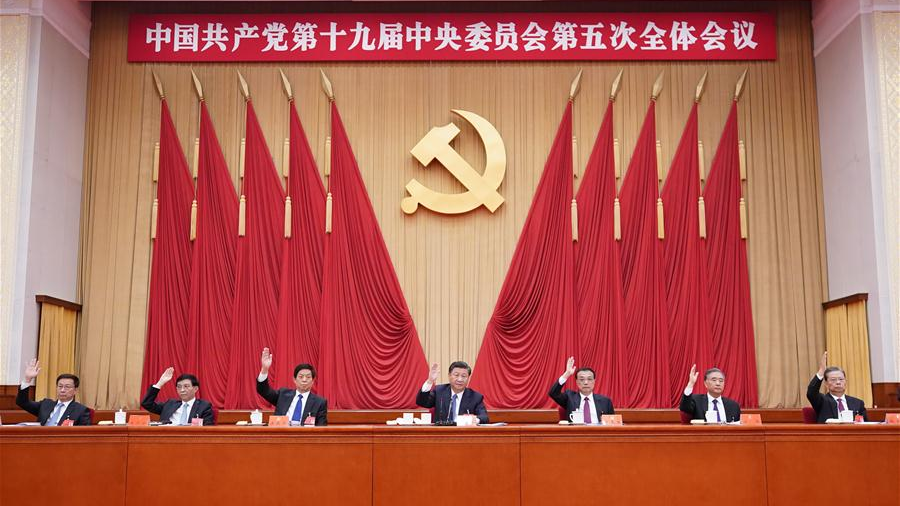
The Political Bureau of the CPC Central Committee presides over the fifth plenary session of the 19th CPC Central Committee in Beijing, capital of China, October 26-29, 2020. /Xinhua
The Political Bureau of the CPC Central Committee presides over the fifth plenary session of the 19th CPC Central Committee in Beijing, capital of China, October 26-29, 2020. /Xinhua
Editor's Note: Andrew Korybko is a Moscow-based American political analyst. The article reflects the author's views and not necessarily those of CGTN.
The fifth plenary session of the 19th Central Committee of the Communist Party of China (CPC) concluded on October 29. The meeting resulted in the formulation of the 14th Five-Year Plan for 2021-2025 and Long-Range Objectives Throughout The Year 2035.
China has accomplished its first centenary goal of building a moderately prosperous society in all respects by 2021 to mark 100 years since the foundation of the CPC and is preparing for its second centenary goal of building a modern socialist country by 2049 to commemorate a century since the founding of the People's Republic of China.
The new development paradigm of dual circulation, which emphasizes a balanced relationship between internal and external circulation, was announced as the next step towards the second centenary goal. This outlook aims to continue the policies of reform and opening-up while prioritizing innovation as the primary driving force behind development. Increased self-reliance also plays an important role for reasons of long-term economic security but the leadership reassured everyone that it's not in conflict with the trend of openness, but rather complements in a strategic way by fostering more domestic development and internal circulation.
The two centenary goals are converging, with 2035 as the midpoint between these historic moments, hence the long-range objectives that China aims to meet by that year. The 14th Five-Year Plan marks a new starting point towards the second centenary goal and will focus on ensuring high-quality development in the material and cultural spheres. It was significantly noted that socialist modernization is impossible without a thriving socialist culture, hence why one of the goals is to develop what was described as a Great Socialist Society by 2035. This reaffirms the CPC's commitment to the people's social and cultural needs.

Xi Jinping, Li Keqiang, Li Zhanshu, Wang Yang, Wang Huning, Zhao Leji and Han Zheng attend the fifth plenary session of the 19th CPC Central Committee in Beijing, China. /Xinhua
Xi Jinping, Li Keqiang, Li Zhanshu, Wang Yang, Wang Huning, Zhao Leji and Han Zheng attend the fifth plenary session of the 19th CPC Central Committee in Beijing, China. /Xinhua
China is transitioning from a middle-income to a high-income country, yet the external environment is characterized by uncertainty and rapid changes. The new development paradigm of dual circulation aims to ensure maximum flexibility for responding to unforeseen challenges, and the driving role of innovation will guarantee that China is able to make significant breakthroughs that see it strengthening its integral role in the global economy. With an eye on economic trends, scientific and technological development will wisely be prioritized above other sectors, thus resulting in China retaining its leadership in these spheres.
While some observers are understandably pessimistic about the world's future outlook, the CPC is actually much more optimistic about how everything will unfold across the coming years. One of its representatives powerfully predicted that it'll be impossible to decouple the Chinese and American economies like a fringe minority of people across the world want to see happen. Their economic structures are too complementary for that to happen, and actually, a 16 percent year-on-year growth in Chinese-American trade was observed in the third quarter of 2020 despite the current global challenges, which grants credence to this optimistic prediction.
When analyzing the 14th Five-Year Plan, the Long-Range Objectives Throughout The Year 2035, and the second centenary goal, one mustn't neglect the core importance of the CPC and the nature of China's governing system for actualizing these ambitions. Unlike the U.S. and other countries which employ Western democratic models, China's communist leadership has a unity of vision unhindered by petty partisan disputes. This grants it a competitive edge, which inspires confidence across the world. The CPC is able to flexibly and decisively respond to unforeseen domestic and global challenges as evidenced by its success in containing COVID-19 for example.
Looking forward, officials confirmed that China is well on its way to realizing the second centenary goal after impressively accomplishing the first one. The new development paradigm of dual circulation and the leading role of innovation in driving growth are strategic breakthroughs that others across the world will surely follow. China has proven that it's a responsible global economic leader with an obligation to assist the world's recovery from the COVID-19 crisis. As one of the CPC's representatives concluded, crises can turn into opportunities, and China's post-pandemic growth is an opportunity for all.
(If you want to contribute and have specific expertise, please contact us at opinions@cgtn.com.)